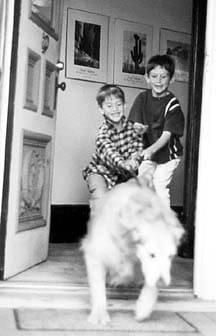As a holistic behavior consultant, I believe that most problems people experience with their dogs are not really dog problems but rather communication problems. Dogs don’t have problems being dogs; they have problems being dogs who live with humans. Most humans don’t even know how to communicate with each other!
Every interaction you have with a dog teaches the dog something about living with a human. However, people speak a verbal language without understanding the language of the body, and dogs don’t speak a language but are masters at understanding the subtleties of body language. So, regardless of what your words say, your dog mostly responds to the sound of your voice, your facial expressions, your body language, and actions.
When dogs interpret your message differently than the way you had intended, they may well respond with behavior that makes no sense to you but makes perfect sense to them. If a dog begins to respond to you and to things in your world with behavior that seems unusual, and is troublesome to you, don’t ask, “What’s wrong with the dog?!” Instead ask, “What am I doing that causes my dog to behave this way?” When you have the answer to that question, then you can change what you are doing and the dog’s behavior will change, too.

When YOU Are Your Dog’s Trigger
This concept was amply illustrated in a case I helped solve.
I received a call from Karin, a woman with a husband and two young children, and a wonderful Golden Retriever named Leon. Karin was very distressed and desperate about some of Leon’s behavior. It seems that the dog, a neutered, adult male who was usually sweet, kind, and trustworthy, had become a serious menace whenever there were people at the door. He had actually bitten two children who had come over to play with Karin’s children. His door manners were totally out of control and nothing they had been told to do had altered his behavior.
The family’s major sources of information had been Leon’s previous trainer and their veterinarian. The trainer had told them to grab his collar, stare him in the eyes and yell NO! in his face. This caused him to stop for the moment but each subsequent encounter at the door became worse.
Their veterinarian told them that when Leon went ballistic at the door they should grab him, choke him with a choke collar, pin him down, and yell at him to stop. Karin and her husband tried everything that had been suggested, but Leon’s door behavior had worsened. On the recommendation of a friend, and as a last resort, they called me. If I was unable to change the dog’s behavior, they were going to put him to sleep.
If they hadn’t cared so much for the dog, the family would never have tried so hard to remedy the situation. But – except for this single dangerous behavior – Leon was a perfect canine companion for Karin and her family. He was devoted to each family member, patient to a fault, and exhibited a lovely, playful, gentle sense of humor when he romped with the children. They adored the dog, and couldn’t for the life of them understand why visitors to the house brought out the worst in him.
Get to the Root of the Aggression
It was easy for me to guess that Leon was associating a knock, the doorbell, and/or the arrival of people at the door, with an unpleasant response directed toward him. It was confrontational, painful, and invasive. A smart dog like Leon could very easily become convinced that whoever was on the other side of the door should just go away!
The other thing that I considered – as I always do in every behavior case – was that Leon may be in need of medical attention. Very often, behavior problems have their roots in a health problem: a sore back, say, or an infection of some kind.
I asked about Leon’s health history, and my suspicions were confirmed: Leon had been treated with antibiotics several times for recurrent infected ears before his veterinarian realized that his infections may have been caused by a food allergy. Allergy tests determined that Leon was allergic to almost every food available.
The veterinarian prescribed a special Fish and Potato diet that the family could buy only through him. The infections in Leon’s ears still became infected now and again, but less frequently than before the change of diet. It’s easy to see how a dog with multiple food allergies and painfully infected ears might respond irritably to a loud, chaotic scene. I suspected that these health problems – and perhaps other, undiagnosed problems – might have played a part in the development of Leon’s behavior problem. To eliminate the possibility that other health issues were contributing to the escalation of the hostilities, I asked that Karin take Leon back to her veterinarian and have a blood work-up and urinalysis performed.
No Hope for an Aggressive Dog
It was a week or more before I heard from Karin again. She told me that had taken Leon to the veterinarian, as I requested, but following the visit, her whole family had been ill. I was sympathetic, but asked how the veterinary visit went.
Well, she told me, when she brought Leon into the veterinarian’s office, he was very harsh with her. He told her that since Leon had already bitten two people she should just put him to sleep. He said that if another bite occurred and she wound up in court, he would testify against her for being a negligent owner! No wonder the whole family immediately got ill! They were literally “sick with worry” over this new threat to their beloved dog.
Fortunately, the test results came back without abnormalities. I told Karin that I could not promise that we could fix the problem, but that there were many things we could try.
Experimenting with Solutions
The first thing I suggested was a change to a fresh food diet. The diet was to include a large variety of foods with an emphasis on carbohydrates. Some evidence suggests that increasing the carbohydrates in the diets of aggressive dogs seems to reduce their levels of aggression. However, due to the lectures Karin had received from her veterinarian regarding “strange foods,” she was reluctant to “stir things up” with Leon’s diet again.
Next, I emphatically advised that the family stop “attacking” the dog at the door. It was my opinion that the advice from the trainer and the veterinarian had actually made the situation worse. Leon now knew that when the doorbell rang he would be attacked and he was very resentful of this. The sound of the bell made him furious and he really wanted whoever was there to just go away so he would be safe.
I also explained how to teach Leon some basic word recognition using the click/treat technique. He very quickly learned Sit, Down, and Stay. For the first time, he seemed to enjoy the learning process because there were food treats instead of choking jerks.
Now that he understood these words, the next step was to set up a “mock visitor” scene at the door. Karin’s husband would ring the bell and when Leon dashed to the door in his furious way, Karin would quietly tell him to Sit and Stay, and only when he had done so would she open the door. Karin was to keep her attention focused on Leon and he was to be leashed during this process.
After two weeks of trying this, Karin reported some improvement in Leon’s behavior, but not as much as I had hoped. This led me on an investigative journey to determine what else was going on.
I requested they make an appointment with Dr. Anne Smith, a holistic veterinarian. I hoped that by considering the “whole dog,” Dr. Smith might be able to detect some physical issues that had not shown up on the lab work. Also, I thought Dr. Smith might be able to overcome Karin’s hesitation to change Leon’s diet.
A Toxic Diet
Upon examining Leon, Dr. Smith pointed out that the dog was overweight and had a layer of fatty tissue that was hard and sensitive. This implied to her that Leon was not getting good nutrition and needed to detoxify.
Dr. Smith recommended feeding Leon fresh food, as I knew she would. She explained that the inflamed ears were his body’s way of trying to detoxify itself. The poisons take the path of least resistance and very often that leads to the ears. The allergies were a sign of the poor nutrition and the body being overwhelmed with trying to keep up with the vaccines, allergy shots, poor food, drugs, stress, etc., that he had been subjected to. She prescribed some supplements, a homeopathic remedy, fresh food and an ear cleaning system.
Three weeks later, on their follow-up visit, Leon exhibited vast improvement. His ears were much better, he had lost a little weight, he was tolerating many foods and he definitely was not as jittery as on the first visit.
Seeing the Entire Picture
Now that he felt better, it was time to resume behavior work. I wasn’t sure of what I was going to suggest next, since the scene that I had suggested earlier hadn’t seemed to make much of a difference. However, when you are in the dark, often someone will turn on a light.
As it happened, the light turned on while Karin and I were on the phone. We were discussing the problem when Karin’s doorbell rang. Karin’s voice immediately tightened and rose in pitch, and she blurted out for me to hold on. She dropped the phone and I could hear her running away from the phone, presumably toward the door. The chaos that followed was very illuminating.
At the sound of the bell, Leon had begun barking ferociously. Karin’s children began yelling at the person on the other side of the door, “Who’s there? What do you want?” Karin was yelling at Leon and the kids. The noise was so loud I had to take the phone away from my ear! When Karin came back on the line, I told her we needed to set up another appointment immediately, and that every person in the family must attend!
At this meeting I told them what I had learned from this phone call. The situation definitely involved everyone in the family. Leon was not the only one who was out of control; the whole family was overreacting! Karin was obviously distressed and worried that Leon would attack the visitor. The children were nervous with anticipation of another dog-biting scene, and overly excited about the prospect of visiting with their friends. Because most of the people who rang the family’s doorbell were friends, most of the visitors were also aware of the whole scene and responded with understandable uneasiness. Leon responded to the chaos and confusion with a very predictable, learned response.
Think about how the scenes at the front door must seem to Leon, I told Karin.
You can actually picture it like a play:
Stage left: The doorbell rings. Center stage: Children run to the door, screaming with excitement and concern. Golden Retriever is following them and then dashes ahead of them.
Stage right: Nervous, anxious mother approaches, screaming out orders to the children and the unknown person on the other side of the door with great fear and worry. She grabs the dog, and as the door opens and new people arrive on the scene, she begins yelling at and choking him. Everyone in the scene is agitated, excited, and concerned.
I suggested that this scenario probably repeated itself with perfect, precise performances each and every time the cue of a knock or the door bell was given, like a miniature stage show waith every character playing his role to perfection. The key would be to change the script!
Putting a New Plan in Place
In our next meeting, in simple terms that even the young children could understand, I explained my “play” analogy, and that everyone would be receiving new parts and new lines in the new play. From now on, the family would be calm, cool, and collected when the bell rang – whether it was a training exercise for Leon or whether someone was really at the door. No more yelling. No more running. No more crowds at the door.
Next, they would practice a new “scene,” set up to help Leon get over his anticipation of pain and discomfort that the bell brought on. Someone would ring the doorbell and no one would respond at all. At first, Leon would probably run to the door and bark – and none of them should respond. Everyone in the house would continue as if they had never heard the bell, or Leon’s barking. I instructed the family to do this over and over, as many times a day as possible.
As soon as they noticed that Leon no longer dashed to the door at the sound of the bell but instead, looked to see what the other members of the family were doing, then one person, not the entire family, would calmly walk to the door, saying nothing at all. They were to open the door, admit the person who rang the bell (usually, this was to be another member of the family), close the door and go back and sit down.
Under no circumstances was any family member to become noisy, excited, or animated when the doorbell rang, even if they had a visitor “for real.” They needed to calmly and quietly greet their friends and then leave the door area.
Leon’s Breakthrough
After several days of doing this, Karin called to say that they had made great strides. She also told me about an experience that really “opened the door” for more success. She and Leon had been in the front yard, with Leon on a leash. When she tried to get back into the house, she discovered that the front door was locked, so she rang the bell to get one of the children to open the door.

At the sound of the bell, she said Leon looked totally stunned. He looked at her and looked at the door. He knew that sound but this time he was on the other side of the door. It totally bewildered him how this could have happened! He just kept looking at her and looking at the door. When one of Karin’s children answered the door (calmly, of course!), he just sat down and stared at everyone. It was as if he had a revelation. Suddenly he was the guest, trying to get in!
The combination of all these approaches – top-notch laboratory work, holistic veterinary care, fresh food, positive reinforcement education, changing the family’s response to the cue of the doorbell – finally did the trick.
After a few weeks with their new “script,” Leon still exhibited a little excitement when the bell rang, but he no longer responded with furious, out of control behavior. The children, too, learned not to get wild with excitement when someone comes to visit. Karin and her husband also became much calmer and no longer had to suffer a spike of high blood pressure when the doorbell rang!
Author Linda Goodman is a frequent contributor to WDJ. She also operates PORGIE Teaching Center in Riverside, CA.






